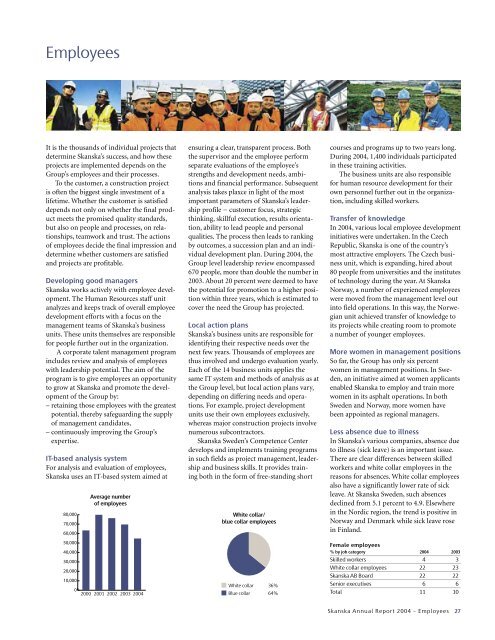ANNUAL REPORT 2004 - Skanska
ANNUAL REPORT 2004 - Skanska
ANNUAL REPORT 2004 - Skanska
You also want an ePaper? Increase the reach of your titles
YUMPU automatically turns print PDFs into web optimized ePapers that Google loves.
Employees<br />
It is the thousands of individual projects that<br />
determine <strong>Skanska</strong>’s success, and how these<br />
projects are implemented depends on the<br />
Group’s employees and their processes.<br />
To the customer, a construction project<br />
is often the biggest single investment of a<br />
lifetime. Whether the customer is satisfied<br />
depends not only on whether the final product<br />
meets the promised quality standards,<br />
but also on people and processes, on relationships,<br />
teamwork and trust. The actions<br />
of employees decide the final impression and<br />
determine whether customers are satisfied<br />
and projects are profitable.<br />
Developing good managers<br />
<strong>Skanska</strong> works actively with employee development.<br />
The Human Resources staff unit<br />
analyzes and keeps track of overall employee<br />
development efforts with a focus on the<br />
management teams of <strong>Skanska</strong>’s business<br />
units. These units themselves are responsible<br />
for people further out in the organization.<br />
A corporate talent management program<br />
includes review and analysis of employees<br />
with leadership potential. The aim of the<br />
program is to give employees an opportunity<br />
to grow at <strong>Skanska</strong> and promote the development<br />
of the Group by:<br />
– retaining those employees with the greatest<br />
potential, thereby safeguarding the supply<br />
of management candidates,<br />
– continuously improving the Group’s<br />
expertise.<br />
IT-based analysis system<br />
For analysis and evaluation of employees,<br />
<strong>Skanska</strong> uses an IT-based system aimed at<br />
<br />
<br />
<br />
<br />
<br />
ensuring a clear, transparent process. Both<br />
the supervisor and the employee perform<br />
separate evaluations of the employee’s<br />
strengths and development needs, ambitions<br />
and financial performance. Subsequent<br />
analysis takes plaxce in light of the most<br />
important parameters of <strong>Skanska</strong>’s leadership<br />
profile − customer focus, strategic<br />
thinking, skillful execution, results orientation,<br />
ability to lead people and personal<br />
qualities. The process then leads to ranking<br />
by outcomes, a succession plan and an individual<br />
development plan. During <strong>2004</strong>, the<br />
Group level leadership review encompassed<br />
670 people, more than double the number in<br />
2003. About 20 percent were deemed to have<br />
the potential for promotion to a higher position<br />
within three years, which is estimated to<br />
cover the need the Group has projected.<br />
Local action plans<br />
<strong>Skanska</strong>’s business units are responsible for<br />
identifying their respective needs over the<br />
next few years. Thousands of employees are<br />
thus involved and undergo evaluation yearly.<br />
Each of the 14 business units applies the<br />
same IT system and methods of analysis as at<br />
the Group level, but local action plans vary,<br />
depending on differing needs and operations.<br />
For example, project development<br />
units use their own employees exclusively,<br />
whereas major construction projects involve<br />
numerous subcontractors.<br />
<strong>Skanska</strong> Sweden’s Competence Center<br />
develops and implements training programs<br />
in such fields as project management, leadership<br />
and business skills. It provides training<br />
both in the form of free-standing short<br />
<br />
White collar/<br />
blue collar employees<br />
courses and programs up to two years long.<br />
During <strong>2004</strong>, 1,400 individuals participated<br />
in these training activities.<br />
The business units are also responsible<br />
for human resource development for their<br />
own personnel further out in the organization,<br />
including skilled workers.<br />
Transfer of knowledge<br />
In <strong>2004</strong>, various local employee development<br />
initiatives were undertaken. In the Czech<br />
Republic, <strong>Skanska</strong> is one of the country’s<br />
most attractive employers. The Czech business<br />
unit, which is expanding, hired about<br />
80 people from universities and the institutes<br />
of technology during the year. At <strong>Skanska</strong><br />
Norway, a number of experienced employees<br />
were moved from the management level out<br />
into field operations. In this way, the Norwegian<br />
unit achieved transfer of knowledge to<br />
its projects while creating room to promote<br />
a number of younger employees.<br />
More women in management positions<br />
So far, the Group has only six percent<br />
women in management positions. In Sweden,<br />
an initiative aimed at women applicants<br />
enabled <strong>Skanska</strong> to employ and train more<br />
women in its asphalt operations. In both<br />
Sweden and Norway, more women have<br />
been appointed as regional managers.<br />
Less absence due to illness<br />
In <strong>Skanska</strong>’s various companies, absence due<br />
to illness (sick leave) is an important issue.<br />
There are clear differences between skilled<br />
workers and white collar employees in the<br />
reasons for absences. White collar employees<br />
also have a significantly lower rate of sick<br />
leave. At <strong>Skanska</strong> Sweden, such absences<br />
declined from 5.1 percent to 4.9. Elsewhere<br />
in the Nordic region, the trend is positive in<br />
Norway and Denmark while sick leave rose<br />
in Finland.<br />
<br />
<br />
Female employees<br />
% by job category <strong>2004</strong> 2003<br />
<br />
<br />
<br />
<br />
<br />
White collar<br />
Blue collar<br />
36%<br />
64%<br />
Skilled workers 4 3<br />
White collar employees 22 23<br />
<strong>Skanska</strong> AB Board 22 22<br />
Senior executives 6 6<br />
Total <br />
11 10 <br />
<strong>Skanska</strong> Annual Report <strong>2004</strong> – Employees 27<br />
27

















